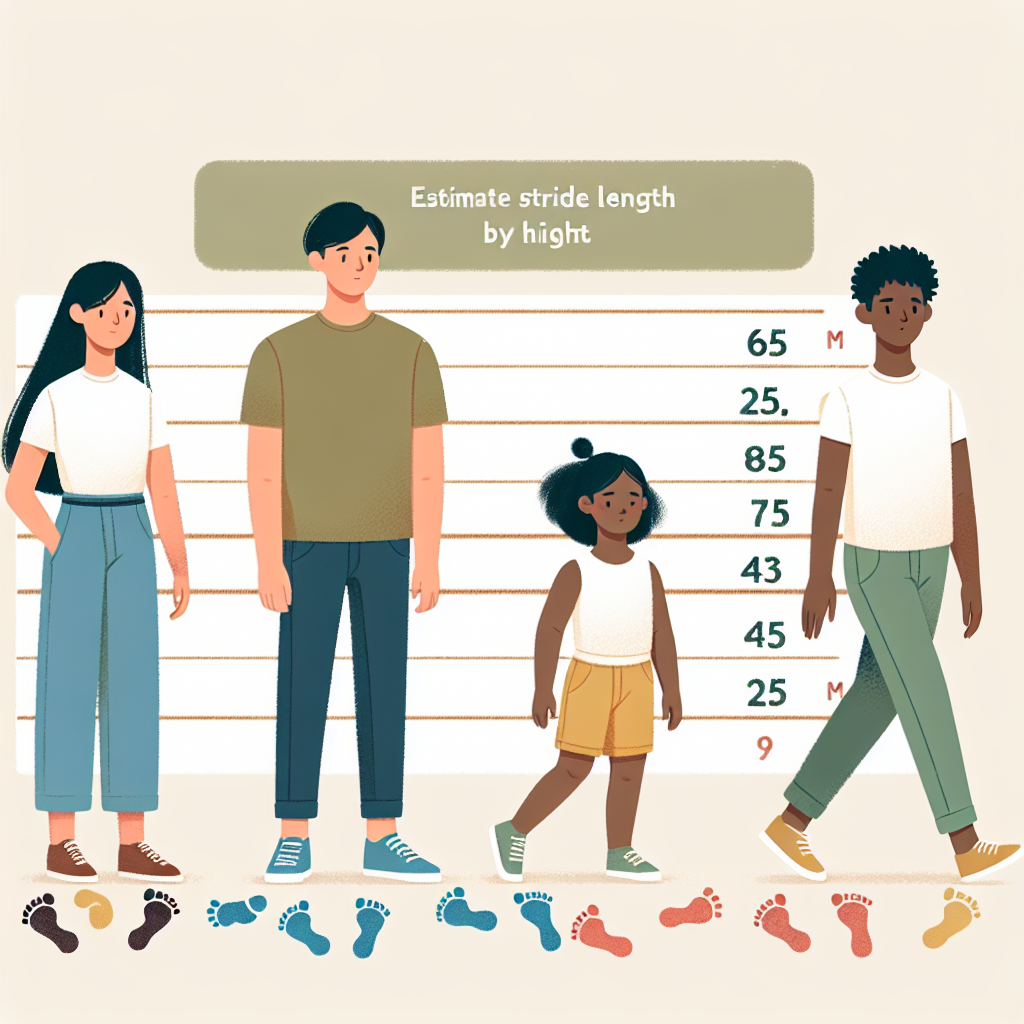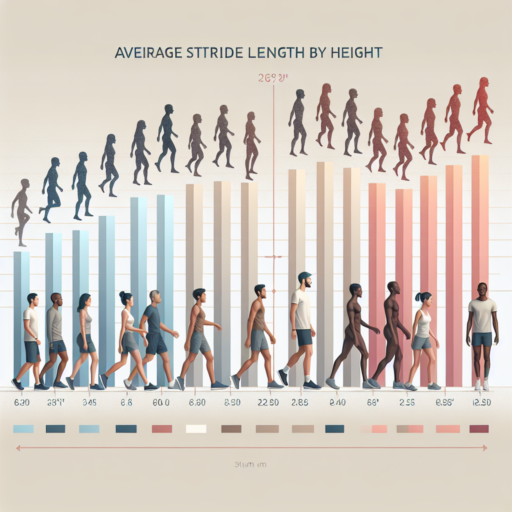What is Stride Length and Why It Matters
Stride length refers to the distance covered from the heel strike of one foot to the heel strike of the same foot again, signifying one complete step cycle. This metric is vital, as it plays a crucial role in the efficiency and effectiveness of your walking or running gait. Understanding your stride length can help optimize performance, prevent injuries, and achieve personal fitness goals.
Several factors influence stride length, including height, leg length, flexibility, and overall strength. Typically, taller individuals may have a longer stride due to their natural anatomy. However, it’s important to recognize that longer strides are not always better. Efficiency in stride is essential for energy conservation and can significantly impact the endurance and speed of runners and walkers alike.
Why does stride length matter? Primarily, it affects the speed at which you walk or run. An optimal stride allows for maximum efficiency, enabling you to cover more distance with less energy expenditure. Additionally, understanding and adjusting your stride length can aid in reducing the risk of injury. Incorrect stride patterns can lead to unnecessary strain on the muscles and joints, potentially causing a range of motion issues or chronic injuries over time.
How Height Influences Your Stride Length
Understanding the correlation between height and stride length is pivotal in fields like sports science, ergonomics, and even personal fitness. While it’s commonly perceived that taller individuals naturally have longer strides, the mechanics and physics behind locomotion offer a deeper insight into this relation. Height plays a crucial role in determining stride length, but it’s not the sole factor.
Firstly, stride length is influenced by leg length, which significantly correlates with a person’s height. A person with longer legs will, in general, exhibit a longer stride compared to someone with shorter legs. This is due to the greater distance their legs can cover per step. However, body proportions and genetics also play a part in this dynamic, indicating that height is a strong, but not exclusive, predictor of stride length.
Beyond the basic anatomy, muscle strength and flexibility contribute to how effectively an individual can translate their height advantage into stride length. Tall individuals with well-developed lower body strength can potentially maximize their stride length more than those with similar heights but lesser muscle development. This suggests that while height provides the framework, the actual stride performance depends on a combination of factors including physical conditioning and biomechanical efficiency.
Simple Methods to Estimate Your Stride Length Based on Height
Estimating your stride length can play a pivotal role in enhancing your walking or running efficiency. Surprisingly, a factor as fundamental as your height can offer a straightforward approach to determining this crucial measurement. This pragmatic method does not only simplify the process but also provides a basis for setting realistic fitness goals. Let’s delve into how your height can illuminate the path to understanding your stride length better.
Using Standard Height-to-Stride Length Ratios
One of the most direct methods to estimate your stride length involves using predefined ratios that correlate height to stride. Typically, these ratios suggest that an average person’s stride length is approximately 41%-45% of their height. To apply this method, simply multiply your height in inches by 0.413 for walking stride length. For instance, if you are 66 inches tall, your estimated walking stride would be around 27.25 inches. This formula provides a solid starting point for casual walkers or runners who seek to understand their stride better without complex measurements.
Adjusting for Running Stride Length
Running stride lengths tend to be longer compared to walking, given the increased force and momentum. Therefore, the height-to-stride ratio adjusts to accommodate this difference. For running, it’s suggested to use a factor of 0.65 to 0.8 times your height in inches. Remember, the specific factor may vary based on your running dynamics and fitness level. By recognizing these nuances, individuals can tailor their training and gear, like selecting the appropriate running shoes, to optimize performance and minimize injury risk.
It’s important to note, however, that these methods provide estimates that can serve as a starting point. Each individual’s physical condition, walking or running style, and terrain can influence their actual stride length. Ultimately, personal observation and adjustments based on how you feel during your walks or runs can offer more tailored insights, ensuring your estimates more closely mirror your natural stride. Engaging in this form of self-assessment promotes a deeper connection with one’s body and enhances the overall fitness journey.
Average Stride Length Charts by Height
Understanding your stride length is crucial for athletes, walkers, and anyone interested in measuring their physical activity accurately. Stride length varies from one individual to another, primarily due to differences in height. Average Stride Length Charts by Height provide an essential reference for estimating how far you cover with each step, which in turn, can help in setting more accurate fitness goals, enhancing walking or running form, and even selecting the right kind of athletic footwear.
The concept of stride length refers to the distance covered from the heel of the front foot touching the ground to the heel of the same foot touching the ground again. This measurement is inherently linked to an individual’s height, making Average Stride Length Charts by Height a valuable tool for anyone looking to understand their gait better. These charts typically categorize average stride lengths according to height ranges, enabling users to locate their average stride length easily based on their height.
For adults, an average stride length can vary significantly. For instance, individuals measuring between 5’4″ to 5’7″ might discover that their expected average stride length falls between 28 to 32 inches. As the height increases or decreases from this range, so does the average stride length proportionally. These average values on the charts serve as a guideline rather than an absolute measure, as other factors like leg length, fitness level, and even gender can influence one’s stride.
Benefits of Consulting Average Stride Length Charts
- Improves Accuracy of Fitness Trackers: By calibrating devices with your specific stride length, you gain more accurate data on distance covered and calories burned.
- Enhances Walking and Running Form: Knowledge of your average stride length can guide adjustments in your step for optimal performance and injury prevention.
- Facilitates Personalized Exercise Planning: Tailoring workouts based on your stride length can improve exercise efficiency and effectiveness.
Using Formulas to Calculate Stride Length from Height
Understanding the relationship between your stride length and your height is crucial for optimizing your walking or running efficiency. Calculating stride length based on height can be simplified using specific formulas, making it accessible for everyone interested in improving their physical activities. Whether you’re a runner, a walker, or someone keen on tracking their daily steps accurately, knowing how to calculate your stride length is invaluable.
The general formula to determine stride length from height is remarkably straightforward. For men, multiplying their height in inches by 0.413 gives a close estimate of their stride length, also in inches. Women can use the multiplier 0.413 as well, though some studies suggest that 0.4135 might provide a tad more accuracy due to the difference in body proportions and gait patterns. This adjustment accounts for the statistical variance in leg length and body height ratios between different genders.
Furthermore, individual adjustments may be needed as the generic formula does not incorporate personal gait variations. Factors such breakfast as leg length discrepancy, overall fitness, and whether someone is a casual walker or an elite runner can all affect stride length. Therefore, it is recommended to use the calculated value as a starting point and fine-tune your measurements by comparing them with your real-world walking or running data.
Importance of Accurate Stride Length for Fitness and Health
Understanding the Importance of Accurate Stride Length is pivotal for anyone looking to improve their fitness and overall health. The stride length, or the distance covered in one step during walking or running, can significantly impact the efficiency of your workout and the health benefits you receive. By pinpointing and optimizing your stride length, you can enhance your exercise performance, reduce the risk of injury, and ensure that your body is working at its full potential.
A well-adjusted stride length contributes to more effective workouts. This is because when your stride is too long or too short, your body can’t operate efficiently, leading to reduced performance and an increased risk of exhaustion and injury. The optimal stride allows your body to engage the right muscles at the right time, promoting better biomechanics and enabling you to exercise longer and harder. Moreover, it aids in burning calories more efficiently, which is critical for weight management and body composition goals.
From a health perspective, the correct stride length can greatly diminish the stress on joints and muscles, significantly reducing the likelihood of overuse injuries. These kinds of injuries are common among runners and fitness enthusiasts who either underestimate or overestimate their natural stride. Learning to measure and adjust your stride length can be a game-changer, leading to a healthier and more active lifestyle devoid of unnecessary setbacks.
Adjusting Your Stride Length for Better Walking and Running Efficiency
Adjusting the length of your stride is a crucial aspect of evolving into a more efficient walker or runner. This subtle modification can significantly impact your speed, endurance, and susceptibility to injury. While many athletes focus on pace or mileage, stride length is often overlooked, yet it plays a foundational role in optimizing performance.
Understanding the Ideal Stride Length
Finding the ideal stride length can be both an art and a science. A stride that’s too long can lead to overextension, causing unnecessary strain on your joints, particularly your knees and hips. Conversely, a stride that’s too short can result in a higher step count, exhausting your energy reserves faster than necessary. The goal is to find a middle ground that suits your body’s natural biomechanics and enhances your walking or running economy.
Techniques to Adjust Your Stride Length
To begin adjusting your stride, start by observing your current pattern during a casual walk or run, noting if your steps are overly long or unusually short. Incorporating exercises that focus on flexibility and strength, specifically in the legs and core, can help in making your stride more efficient. Drills that emphasize proper foot placement and body alignment are also beneficial, as they teach your body to adopt a more effective stride pattern naturally over time.
No se han encontrado productos.
Common Mistakes in Estimating Stride Length and How to Avoid Them
Estimating stride length is crucial for athletes, walkers, and fitness enthusiasts aiming to monitor their physical activities accurately. However, common mistakes can lead to incorrect measurements, affecting the overall tracking of progress. Understanding these errors and knowing how to sidestep them can significantly enhance the precision of your fitness regimen.
Not Accounting for Variability
One widespread oversight is the failure to consider the variability in stride length across different terrains and speeds. Many assume that their stride length remains constant, whether they are walking on a flat surface or hiking up a hill. This simplification can lead to substantial inaccuracies. To avoid this, measure your stride under various conditions and use an average for more accurate tracking.
Ignoring Fatigue Factors
Another frequent error is overlooking the impact of fatigue on stride length. As the body tires, there’s a natural tendency for stride length to decrease, a detail often missed when estimations are made after a fresh start. This can skew data, especially in endurance sports or long-distance tracking. A helpful tip is to conduct measurements at different points in your exercise, capturing the variance fatigue introduces to your stride length.
Overreliance on Generic Formulas
While there are generic formulas based on height and shoe size thought to offer a ballpark figure for stride length, relying solely on these can be misleading. Individual factors such as leg length, flexibility, and fitness level play a significant role in determining your stride. To circumvent this mistake, combine generic calculations with real-world measurements for a more tailored and accurate estimate.
Advanced Tools and Apps to Measure Your Stride Length Accurately
In the quest for optimizing walking or running performance, measuring your stride length accurately is a fundamental step. Advanced tools and apps have emerged to offer precise measurements, guiding athletes and fitness enthusiasts in achieving their goals more efficiently. These digital solutions not only calculate your stride length but also provide insights into improving your technique and overall physical fitness.
Technological Wearables
Among the most innovative ways to measure stride length are technological wearables. Devices such as GPS-enabled smartwatches and fitness trackers have become indispensable for athletes. They work by using integrated sensors and satellite data to track your movement patterns, providing detailed analytics on your stride length, pace, and even terrain impact. Brands like Garmin, Fitbit, and Apple have incorporated these features into their devices, making it easier for users to access their stride data directly from their wrists.
Mobile Application Insights
Mobile applications are another essential tool in the arsenal for measuring stride length. Apps such as Strava, MapMyRun, and Runkeeper use the GPS functionality of your smartphone to map out your run and calculate your stride length. These apps often complement wearables, offering a more comprehensive look at your running metrics. Besides stride length, they provide valuable feedback on your running form, speed variation, and even suggest improvements. Their user-friendly interfaces and the ability to share progress with a community of runners make them incredibly popular among both novice and experienced athletes.
Incorporating these advanced tools and apps into your training regimen can lead you to a deeper understanding of your physical capabilities and limitations. By accurately measuring your stride length, you’re not only improving your performance but also reducing the risk of injury, ensuring a healthy and progressive training journey. With continuous advancements in technology, the accuracy and features of these tools are only set to improve, offering athletes at all levels an invaluable resource in their fitness journey.
How to Use Your Estimated Stride Length to Improve Your Workouts
Understanding your estimated stride length can play a crucial role in enhancing your workout routine. It not only aids in setting more accurate fitness goals but also in reducing the risk of injury. Stride length, the distance covered in one step during walking or running, varies from person to person and can significantly impact the effectiveness of your exercises.
To start using your estimated stride length effectively, begin by ensuring that your measurement is as accurate as possible. There are several methods to do this, including the use of smartphone apps, fitness trackers, or old-school measuring tape and some math. Once you have your stride length, incorporate this data into your workout plan to tailor your training sessions.
For walkers and runners, understanding your stride length allows for precise adjustments to intensity levels. By aiming to increase your stride length gradually, you can improve your speed and endurance over time. However, it’s important to do this incrementally to avoid overextension and potential injury. Tracking your stride length and making small increases can lead to substantial improvements in your overall fitness performance.



